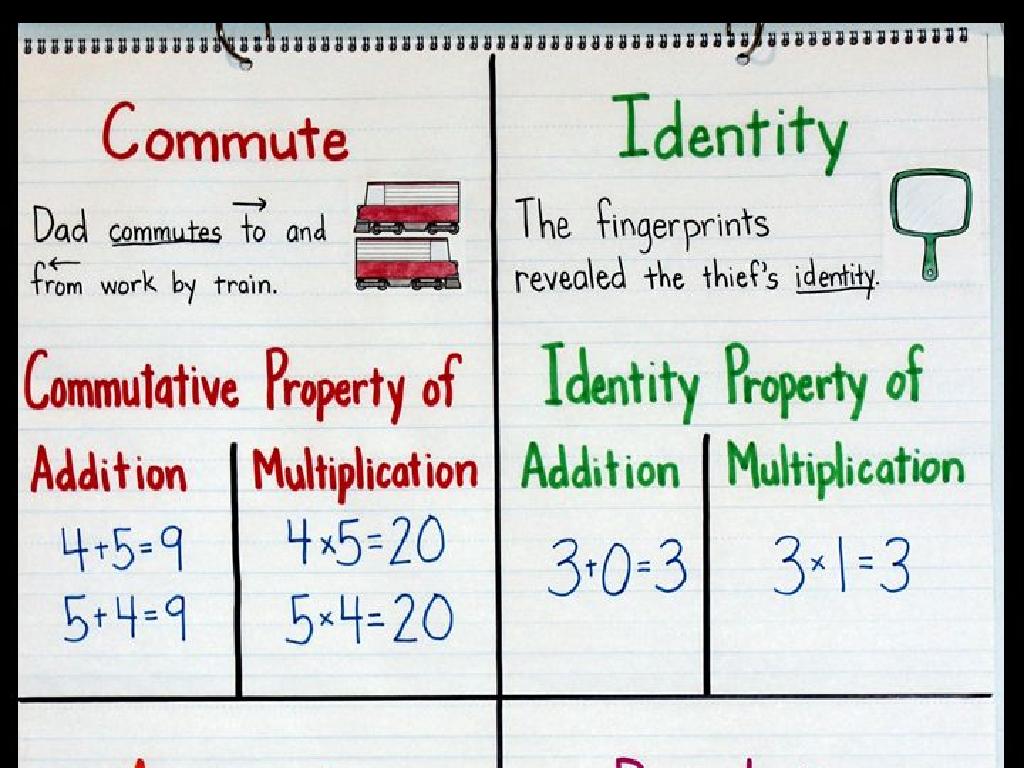Fractions Of Number Lines
Subject: Math
Grade: Third grade
Topic: Fractions On Number Lines
Please LOG IN to download the presentation. Access is available to registered users only.
View More Content
Welcome to Fractions on Number Lines!
– Fractions show parts of a whole
– Like a pizza cut into slices
– Number lines help visualize fractions
– Each point on the line is a fraction
– Everyday examples of fractions
– Sharing snacks, reading a ruler
– Practice placing fractions on a line
– We’ll draw number lines and mark fractions
|
This slide introduces the concept of fractions as parts of a whole, using relatable examples like slices of pizza to illustrate the idea. It also explains how number lines can be used as a tool to visualize and better understand fractions. Provide everyday examples where fractions are used, such as dividing a bag of snacks among friends or measuring lengths with a ruler. The slide sets up an activity where students will practice placing fractions on a number line, reinforcing their understanding of the concept. Encourage students to think of other examples of fractions they encounter in daily life to make the lesson more engaging.
Understanding Fractions on Number Lines
– A fraction shows part of a whole
– Top and bottom numbers explained
– Numerator: how many parts we have. Denominator: how many equal parts the whole is divided into.
– Fractions in everyday life
– Pizza slices, sharing candy, and measuring cups are all examples of fractions we see daily.
– Placing fractions on a line
– Imagine a number line as a long, stretched out pizza, where we can mark the slices to show fractions.
|
Begin by explaining that a fraction represents a part of a whole, like a slice of pizza out of a whole pizza. The top number, or numerator, indicates how many parts we’re talking about, while the bottom number, or denominator, shows how many of those parts make up a whole. Use relatable examples such as slices of pizza, pieces of candy, or amounts in measuring cups to illustrate fractions in daily life. Then, introduce the concept of a number line and demonstrate how fractions can be represented on it, which will help students visualize fractions as parts of a whole. Encourage students to think of their own examples and to practice placing fractions on a number line.
Fractions on Number Lines
– What is a number line?
– A straight line with numbers at equal spaces
– Number lines show order of numbers
– See how numbers are arranged from least to greatest
– Representing whole numbers and fractions
– Points on the line stand for whole numbers like 1, 2, 3
– Using number lines for fractions
– Fractions are between whole numbers, like 1/2 is between 1 and 2
|
This slide introduces the concept of number lines and their use in understanding the order and value of numbers, including fractions. A number line is a visual representation that helps students grasp the concept of sequencing and comparing numbers. It’s crucial to emphasize that each point on the line corresponds to a number, and spaces between whole numbers can be divided into equal parts to represent fractions. Encourage students to think of a number line as a ruler, where fractions are like the smaller lines between the inch marks. This will help them visualize and better understand fractions in a concrete way.
Placing Fractions on a Number Line
– Fractions fit between whole numbers
– Divide spaces into equal parts
– If a space is split into 4, each part is 1/4
– Parts match the fraction’s denominator
– A denominator of 5 means 5 parts between whole numbers
– Practice placing fractions correctly
|
This slide introduces students to the concept of placing fractions on a number line. Begin by explaining that fractions represent numbers that are not whole, and they can be located between the whole numbers on a number line. Illustrate how each space between whole numbers can be equally divided to represent fractions. The number of divisions will correspond to the denominator of the fraction; for example, if the denominator is 4, then the space between each whole number is divided into 4 equal parts. Encourage students to practice by giving them a number line and asking them to place fractions like 1/4, 3/4, 2/5, etc., on it. This will help them visualize fractions and understand their relative size.
Placing Fractions on Number Lines
– Example: Placing 1/2 on a line
– Imagine cutting a cake into 2 equal parts; 1/2 is one part
– Placing 1/4 and 3/4 correctly
– If we cut the same cake into 4 pieces, 1/4 is one piece and 3/4 are three pieces
– Number lines divided into fractions
– Each space between numbers represents a fraction based on how many cuts we make
– Understanding fractions visually
|
This slide aims to help students visualize fractions by placing them on a number line. Start with simpler fractions like 1/2 to ensure understanding, then move to 1/4 and 3/4, which introduces the concept of dividing a whole into more parts. Explain that the number line is like a whole item, and the marks on the line are like cuts that divide it into equal parts. Use real-life examples, such as cutting a cake or a pizza, to make the concept relatable. Encourage students to draw their own number lines and place fractions on them. This will help solidify their understanding of how fractions represent parts of a whole and their relative size.
Your Turn: Practice with Fractions
– Let’s place fractions on a number line
– We’ll divide the number line into fractions
– Imagine cutting a cake into equal parts; each part is a fraction of the whole cake.
– Find where each fraction goes on the line
– If we cut a line into 4 pieces, where would 1/4 or 3/4 go?
– Make sure your fractions are in the right spot
|
This slide is an interactive activity for students to apply their knowledge of fractions on a number line. Start by explaining that a number line can be divided into equal parts, just like a whole item, such as a cake, can be cut into fractions. Have students visualize dividing the number line into equal sections, and then ask them to place given fractions in the correct location. For example, if the number line is divided into fourths, where would they place 1/4 or 3/4? Provide guidance and ensure they understand that each point on the line represents a fraction of the whole. This hands-on activity will help solidify their understanding of fractions and their representation on number lines. Prepare to offer assistance and have additional examples ready for students who may need extra help.
Class Activity: Fraction Number Line Art
– Create a colorful number line
– Use colors for different fractions
– Each fraction has its own space
– Mark equal spaces for fractions like 1/2, 1/4, 1/8 on your line
– Share your art with the class
|
In this engaging class activity, students will apply their knowledge of fractions by creating a number line art project. Provide students with long strips of paper and colored pencils or markers. Guide them to draw a number line and mark equal intervals for common fractions such as 1/2, 1/4, and 1/8. Encourage creativity by having them use different colors to represent each fraction. Once completed, students will present their number line to the class, explaining their choice of colors and intervals. This activity will help solidify their understanding of fractions on a number line and give them practice in explaining mathematical concepts. Possible variations include using stickers, stamps, or other craft materials to represent different fractions.
Wrapping Up: Fractions on Number Lines
– Recap: Fractions on lines
– We learned how to plot and identify fractions on a number line.
– Importance of fractions
– Fractions help us divide things equally and understand parts of a whole.
– Fractions in daily life
– Pizza slices, measuring cups, and clock times are everyday fractions.
– Review with examples
|
As we conclude today’s lesson, let’s review what we’ve learned about fractions on number lines. We’ve seen how each point on a number line can represent a fraction, and how this visual representation helps us understand the value of fractions. We discussed the importance of fractions in everyday life, such as in cooking or telling time. Encourage students to think of other examples where they encounter fractions daily. This will help solidify their understanding and see the relevance of fractions beyond the classroom. For the next class, prepare a few examples to share, and we’ll discuss how fractions appear in various situations.
Homework: Exploring Fractions on Number Lines
– Complete the worksheet provided
– Fill in the number lines with correct fractions
– Practice fractions on a number line
– Use the number line to place fractions correctly
– Share your answers in the next class
– Be prepared to discuss how you found your answers
|
This homework assignment is designed to reinforce the day’s lesson on placing fractions on a number line. The worksheet will have a series of number lines with fractions that students need to plot correctly. Encourage students to practice at home by drawing their own number lines and placing fractions on them. Remind them to consider the space between whole numbers as divided into equal parts to help them determine where fractions should be placed. In the next class, students will have the opportunity to share their answers and discuss the strategies they used to determine the correct placement of each fraction. This will help them to verbalize their thought process and solidify their understanding of the concept.






